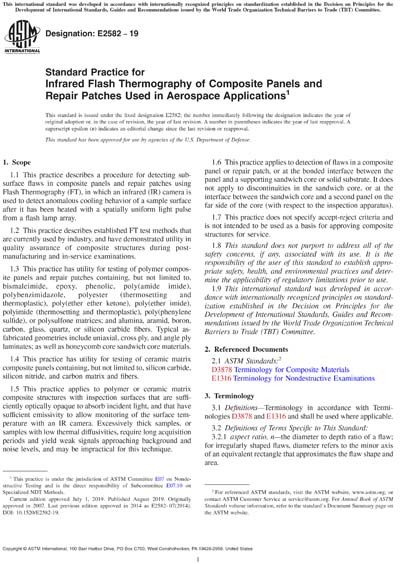Historical
ASTM E2582-19
Standard Practice for Infrared Flash Thermography of Composite Panels and Repair Patches Used in Aerospace Applications
1.1 This practice describes a procedure for detecting subsurface flaws in composite panels and repair patches using Flash Thermography (FT), in which an infrared (IR) camera is used to detect anomalous cooling behavior of a sample surface after it has been heated with a spatially uniform light pulse from a flash lamp array.
1.2 This practice describes established FT test methods that are currently used by industry, and have demonstrated utility in quality assurance of composite structures during post-manufacturing and in-service examinations.
1.3 This practice has utility for testing of polymer composite panels and repair patches containing, but not limited to, bismaleimide, epoxy, phenolic, poly(amide imide), polybenzimidazole, polyester (thermosetting and thermoplastic), poly(ether ether ketone), poly(ether imide), polyimide (thermosetting and thermoplastic), poly(phenylene sulfide), or polysulfone matrices; and alumina, aramid, boron, carbon, glass, quartz, or silicon carbide fibers. Typical as-fabricated geometries include uniaxial, cross ply, and angle ply laminates; as well as honeycomb core sandwich core materials.
1.4 This practice has utility for testing of ceramic matrix composite panels containing, but not limited to, silicon carbide, silicon nitride, and carbon matrix and fibers.
1.5 This practice applies to polymer or ceramic matrix composite structures with inspection surfaces that are sufficiently optically opaque to absorb incident light, and that have sufficient emissivity to allow monitoring of the surface temperature with an IR camera. Excessively thick samples, or samples with low thermal diffusivities, require long acquisition periods and yield weak signals approaching background and noise levels, and may be impractical for this technique.
1.6 This practice applies to detection of flaws in a composite panel or repair patch, or at the bonded interface between the panel and a supporting sandwich core or solid substrate. It does not apply to discontinuities in the sandwich core, or at the interface between the sandwich core and a second panel on the far side of the core (with respect to the inspection apparatus).
1.7 This practice does not specify accept-reject criteria and is not intended to be used as a basis for approving composite structures for service.
1.8 This standard does not purport to address all of the safety concerns, if any, associated with its use. It is the responsibility of the user of this standard to establish appropriate safety, health, and environmental practices and determine the applicability of regulatory limitations prior to use.
1.9 This international standard was developed in accordance with internationally recognized principles on standardization established in the Decision on Principles for the Development of International Standards, Guides and Recommendations issued by the World Trade Organization Technical Barriers to Trade (TBT) Committee.
Content Provider
ASTM International [astm]






